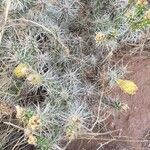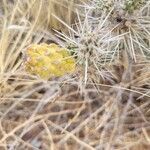Trees or shrubs, low to upright, sparingly to densely branched, some almost matlike in Arizona, 0.3-0.6(-1.5) m; branchlets whorled to subwhorled. Stem segments firmly attached, green, 3-9(-15) × 0.5-1.5(-2.2) cm; tubercles prominent, short, 0.5-1 cm; areoles oval to obdeltate, 2-6 × 1.5-4 mm; wool pale yellow to white, aging gray. Spines (1-)3-8(-10) spines per areole, in all but basalmost areoles, best developed toward apex, interlacing with spines of adjacent areoles, whitish or pale yellow, pale red-brown, sometimes tipped yellow, of 2 kinds; radial spines slender, flattened basally, deflexed, 5-8 mm, surrounding central spines; central spines usually 4(-6), spreading into a cross, stout, subterete, 2-3.4(-4.5) cm; also 0-2 bristlelike spines; sheaths whitish to pale yellow (rarely golden) throughout or tipped yellow to golden. Glochids in adaxial tuft, yellow, 1-3 mm. Flowers: inner tepals yellow to green-yellow, spatulate, 15-25(-30) mm, apiculate; filaments yellowish or yellow-green; anthers yellow; style white to yellowish; stigma lobes whitish, yellowish, or pale green (rarely pink tinged). Fruits rarely proliferating, yellow to greenish yellow, broadly cylindric to subspheric, 18-30(-35) × 15-22(-32) mm, fleshy, tuberculate, spineless; tubercles subequal or distalmost longest, usually prominent; umbilicus 7-8 mm deep; areoles 36-62. Seeds pale yellow, subcircular to slightly angular in outline, flattened to warped, 3-3.5 × 2.5-3.5 mm, sides smooth or with 1-3 depressions; girdle smooth. 2n = 22, 44.
More
A bushy cactus. It is straggling and 1 m high. The joints are dull green and 5-30 cm long by 2 cm wide. There are lumps about 1 cm long and wide. There are 6-10 spines in a spine spot. They are 2.5-5 cm long and have strong barbs. The flowers are pale yellow. They are 3 cm across. The fruit are dry and very spiny. They are 2.5-3 cm long by 1.5-3 cm wide.
Temperate grassland and temperate scrub, also in oak, pinyon or pine forest, and juniper woodlands.; at elevations from 900-2,300 metres.
More
It needs sun. It grows in dry rocky areas. It needs a temperature above 10°C.



